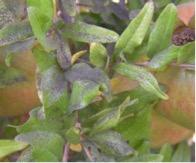Sooty Mold
-
AboutGrows on plants and other surfaces covered withby honeydew, a sticky substance created by some certain insects. Doesn’t infect plants, but the mold can indirectly do damage by coating leaves to the point that sunlight can’t reach the leaf surface. Without adequate sunlight, the plant cannot effectively photosynthesize, which stunts growth.
 Photo: Courtesy UC Regents
Photo: Courtesy UC Regents -
Category
-
Fungi
-
-
Signs/Symptoms
Sooty covering on foliage, stems, and fruit.
Coated leaves also might prematurely age and die, causing premature leaf drop.
Name comes from the dark threadlike growth (mycelium) of the fungi resembling a layer of soot.
-
Where
Foliage, stems, and fruit.
-
When
When plant is infested with insects that secrete honeydew, including aphids, psyllids, mealy bugs, and whiteflies.
-
Prevent
Prevent infestations of honeydew-secreting insects.
Fertilize and water properly to keep plants healthy but not growing excessively.
-
Manage
Remove affected plant parts. Wash with strong stream of water. Use horticultural oil or insecticidal soaps to reduce insect populations. Use ant stakes. Fruits or vegetables that become covered with sooty mold are still edible. Wash off the mold with mild soap and warm water.
-
More Information

